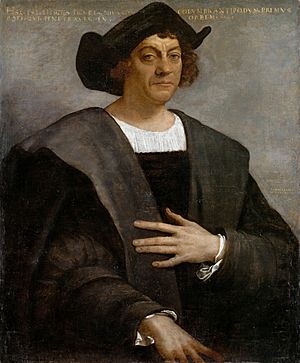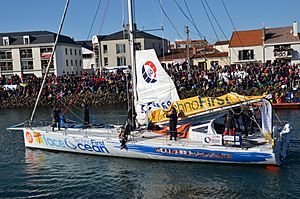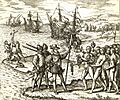Christopher Columbus facts for kids
Quick facts for kids
Christopher Columbus
|
|
|---|---|

Portrait of Christopher Columbus by Sebastiano del Piombo
|
|
| 1st Governor of the Indies | |
| In office 1492–1499 |
|
| Appointed by | Isabella I of Castile |
| Succeeded by | Francisco de Bobadilla |
| Personal details | |
| Born | Before October 31, 1451 Genoa, Republic of Genoa |
| Died | May 20, 1506 (aged c. 54) Valladolid, Castile |
| Resting place | Seville Cathedral, Seville, Spain |
| Spouse | Filipa Moniz Perestrelo |
| Domestic partner | Beatriz Enríquez de Arana |
| Children | Diego Fernando |
| Parents | Domenico Colombo Susanna Fontanarossa |
| Relatives | Brothers: Giovanni Pellegrino Giacomo (also called Diego) Bartholomew Sister: Bianchinetta Columbus |
| Occupation | Maritime explorer |
| Signature | |
| Military service | |
| Rank | Admiral of the Ocean Sea |
Christopher Columbus (1451–1506) was an important explorer and navigator from Genoa, which is now part of Italy. His name in Italian was Cristoforo Colombo. In English, we know him as Christopher Columbus.
In 1492, Columbus sailed from Spain hoping to find a quicker way from Europe to Asia. Instead, he landed on an island in the Bahamas. Many people credit him with "discovering" the New World. This is because Europeans started to colonize America soon after his trip.
While Leif Erikson was the first European to reach the Americas around the year 1000, his journey was not widely known. Columbus's voyages led to lasting connections between Europe and the New World. When the Spanish rulers learned about Columbus's findings, many other explorers, called conquistadors, followed him. This began the Spanish colonization of the Americas.
Columbus passed away on May 20, 1506, in Valladolid, Spain.
Contents
Columbus's Early Life and Goals
Where Was Columbus Born?
Columbus's family said he was born in Genoa, Italy. Most experts agree that Genoa is likely his birthplace. However, some historians believe he might have been born in Spain or Portugal.
His father, Domenico Colombo, was a wool weaver. He also owned a cheese shop where young Christopher helped out. His mother was Susanna Fontanarossa. Christopher had three brothers and one sister. His brother Bartolomeo worked as a mapmaker in Lisbon.
Columbus learned Latin, Portuguese, and Castilian. He studied astronomy, geography, and history. He read books by famous thinkers like Claudius Ptolemy and the travel stories of Marco Polo.
Why Did Columbus Sail West?
Columbus had two main reasons for his journeys to the New World. First, he wanted to find a faster and easier way to reach Asia. Asia was known for valuable goods that Europe wanted. Many people thought his idea of sailing west to Asia was impossible. Columbus wanted to prove them wrong.
Second, Columbus wanted to find gold. Gold was the main type of money at that time. Many historians believe Columbus wanted to become a powerful person. To do that, he needed to find a lot of gold.
The First Voyage in 1492
Planning the Journey
Many people in Western Europe wanted a shorter way to get to Asia. Columbus believed he could reach Asia by sailing west. He did not know that the Western Hemisphere existed. He did not realize it would block his path to Asia.
Columbus did not have enough money to pay for this voyage himself. He asked the rulers of Spain, King Ferdinand II and Queen Isabella I, for help. He promised to bring back gold and spices for them. They agreed to help him after they won a war against the Emirate of Granada.
In August 1492, Columbus and his sailors left Spain. They had three ships: the Santa María (the Holy Mary), the Pinta (the Painted), and the Santa Clara (nicknamed the Niña: the Little Girl).
These ships were quite small. Historians believe the largest ship, the Santa María, was only about 60 feet (18 meters) long. It was about 16 to 19 feet (4.8 to 5.8 meters) wide. The other ships were even smaller, around 50-60 feet (15-18 meters) long.
Landing in the New World
On October 12, 1492, after sailing for about four months, Columbus landed on a small island in the Bahamas. The native people called it Guanahani. Columbus renamed it San Salvador Island, meaning "Holy Savior".
He met Lucayan, Taíno, and Arawak Native Americans living on the island. They were friendly and peaceful. Columbus thought he had reached the "Indies" in Asia, so he called them "Indians." He claimed their land for Spain.
Columbus then sailed to what is now Cuba, and then to Hispaniola. On Hispaniola, he built a fort called Navidad (Spanish for "Christmas"). He left thirty-nine crew members there. He told them to find and store gold.
Columbus's Treatment of Native People
On the day he landed in the Bahamas, Columbus wrote about the Arawaks and Taíno. He thought they would make good servants. He planned to take six of them with him when he left. He saw that some Arawaks wore gold earrings. He took some of them as prisoners. He ordered them to lead him to gold, but they could not.
The Second Voyage
On September 24, 1493, Columbus left Spain again. This time, he had 17 ships and 1,200 men. These men included soldiers and farmers. His goal was to establish Spanish colonies in the New World.
On this trip, Columbus explored some of the Lesser Antilles islands. He also sailed around most of Hispaniola. He explored parts of Jamaica and Cuba he had not seen before.
When he returned to the Navidad fort, he found it burned down. Eleven of the 39 soldiers he left there were gone or buried. Historians believe this happened because of illness and conflicts with the Arawak people.
More About the Treatment of Native People
The soldiers Columbus left at Navidad had started to steal from the Arawaks. This caused the Arawaks to fight back. However, Spain had many powerful weapons the Arawaks had never seen. These included steel swords, pikes, crossbows, trained dogs, and horses. It was easy for Spain to win battles against the Arawaks.
Columbus also sought to punish the Arawaks for the soldiers' deaths at Navidad. He demanded that every native person older than 14 give him a certain amount of gold every three months. If they could not pay the gold, they were forced into slavery.
There was not much gold in the areas Columbus controlled. Many Arawaks tried to escape from Columbus and his men. But Columbus's soldiers used dogs to hunt them down.
The Start of the Transatlantic Slave Trade
In February 1495, Columbus began the transatlantic slave trade. He and his soldiers captured about 1,500 Taíno people. About 400 were released. 600 were kept on the island as slaves for the soldiers. 500 were sent by ship back to Spain. Of those 500, about 200 died during the journey. Half of the survivors were very sick when they arrived. This was the first time people were shipped across the Atlantic Ocean to be sold as slaves.
The Third Voyage
In 1498, Columbus set out to find a continent that King John II of Portugal believed was southwest of the Cape Verde islands. Columbus sent three ships to the West Indies (the Caribbean). He led three other ships. They sailed to Portuguese islands, then to the Canary Islands, and then to Cape Verde.
From Cape Verde, they sailed to the northern coast of South America. They landed in Trinidad. He also explored parts of South America and the islands now called Tobago and Grenada.
On August 19, 1498, Columbus returned to Hispaniola. He found that many Spanish settlers there were unhappy. They thought there would be more gold. Some had rebelled, and Columbus had them punished. In 1499, Queen Isabella sent a man named Francisco de Bobadilla to Hispaniola. She gave him the power to make decisions. When he arrived in 1500, he had Columbus arrested and sent back to Spain.
Treatment of Native People During the Third Voyage
To try and make the Spanish settlers happy, Columbus started the Encomienda system in Hispaniola. He "gave" land, or even a whole village, to a Spanish settler. Any native people living on that land were forced to work for that Spanish settler.
Arrest and Final Voyage
On August 23, 1500, Columbus was arrested in Hispaniola (now called Santo Domingo). He was accused of mistreating native people and Spaniards. He was sent to Spain in chains in October 1500. He was released on December 12, 1500, and appeared in court. Columbus had powerful friends, and the King gave him back his freedom. He was allowed to lead another voyage.
Columbus made a fourth voyage between 1502 and 1504. On this trip, he explored the coast of Central America. He sailed from Belize to Panama. In 1502, off the coast of what is now Honduras, he met a large trading ship. This was the first time the Spanish encountered the advanced civilization of Mesoamerica.
Later, Columbus was stranded on Jamaica for a year. He sent two men by canoe to get help from Hispaniola. While waiting, he impressed the local people by correctly predicting an eclipse of the moon. Help finally arrived, and he returned to Spain in 1504.
Later Life and Death
In his later years, Columbus asked the Spanish Crown for 10% of all profits made in the new lands. He said this was based on earlier agreements. His requests were denied. His family later sued for a share of the profits from trade with America. However, they lost the case about fifty years later.
On May 20, 1506, Columbus died in Valladolid, Spain. He was likely 54 years old. He died from heart failure and arthritis. Even after his death, his body traveled. He was first buried in Valladolid, then in Seville. His son Diego, who was governor of Hispaniola, had his remains moved to Santo Domingo in 1542. In 1795, the French took over, and the body was moved to Havana. After a war in 1898, Cuba became independent. Columbus's remains were moved back to Spain, to the cathedral of Seville. However, some people still claim his bones are in the cathedral of Santo Domingo. In 2016, DNA analysis suggested the bones in Spain were indeed his.
Columbus's Impact and Legacy
The Discovery of America
Columbus was not the first European to reach America. At the time of his voyage, most Europeans did not know the Americas existed. However, Leif Erikson had landed in what is now Canada around AD 1000. Indigenous peoples had lived there for thousands of years before any Europeans arrived. But Native Americans did not record their history in a way that was known to Europeans. So, in European history, Columbus is credited with "discovering" America.
After Columbus's Voyages
When the Spanish learned about the New World, many conquistadors, or conquerors, traveled there. This led to the Spanish colonization of the Americas.
The Spanish conquistadors first settled on the islands of Hispaniola (now the Dominican Republic and Haiti), Cuba, and Puerto Rico. They took as much gold as they could find.
Columbus Day
In the United States, Columbus Day is a holiday that celebrates Columbus's arrival in the New World on October 12, 1492. The World's Columbian Exposition, held in 1893 in Chicago, Illinois, celebrated the 400th anniversary of Columbus's visit to the Americas.
However, many people today do not celebrate Columbus Day. This is because of his harsh treatment of the Indigenous people. Many statues of Columbus have been removed, and parades have stopped. Still, it remains a federal holiday in the U.S.
Interesting Facts About Christopher Columbus
- His birth name in Genoa was Cristoforo Colombo.
- Many people during Columbus's time believed the Earth was flat.
- Before his famous voyages, he used to sell maps and charts.
- The first land they saw in America was the island of San Salvador, about 375 miles off the coast of Florida.
- Columbus never actually set foot on what is now the United States.
- Both Seville Cathedral in Spain and the Columbus Lighthouse in Santo Domingo, Dominican Republic, claim to have Columbus's bones. A 2016 DNA analysis confirmed the bones in Spain were his.
Christopher Columbus Quotes
- "You can never cross the ocean unless you have the courage to lose sight of the shore."
- "Following the light of the sun, we left the Old World."
- "Nothing that results in human progress is achieved with unanimous consent. Those that are enlightened before the others are condemned to pursue that light in spite of the others."
Related Pages
Images for kids
-
Replica of the Santa Maria.
-
Painting of Columbus landing in the New World.
-
Christopher Columbus House in Genoa, an 18th-century reconstruction of the house in which Columbus grew up.
-
Toscanelli's ideas about the Atlantic Ocean, which influenced Columbus's plans.
-
"Columbus map", drawn around 1490 in the Lisbon mapmaking workshop of Bartolomeo and Christopher Columbus.
-
Columbus offers his services to the King of Portugal; Chodowiecki, 17th century.
-
The Alhambra, where Columbus received permission for his first voyage.
-
Replicas of Niña, Pinta and Santa María sailed from Spain to the Chicago Columbian Exposition in 1893.
-
The Discovery of America sculpture, depicting Columbus and a cowering Indian maiden, stood outside the U.S. Capitol from 1844 to 1958.
-
The Spanish Empire (red) in 1598, under Philip II, King of Spain and Portugal.
-
The Columbus Monument in Columbus Circle, New York City.
-
Lighthouse in homage to Christopher Columbus in Santo Domingo.
-
Tomb in Seville Cathedral. The remains are borne by kings of Castile, Leon, Aragon and Navarre.
See also
 In Spanish: Cristóbal Colón para niños
In Spanish: Cristóbal Colón para niños

























